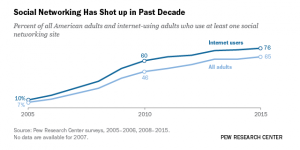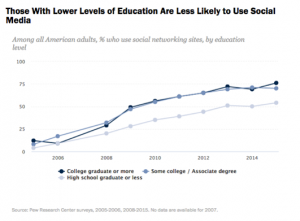 Two-thirds of all internet users, and 65% of all adults over 18 years of age, use social networking sites. Social Media Usage: 2005-2015, the latest report from the Pew Research Center, finds social networking is the new normal for people up to 65 years of age. One-third of people over 65 use social networking sites.
Two-thirds of all internet users, and 65% of all adults over 18 years of age, use social networking sites. Social Media Usage: 2005-2015, the latest report from the Pew Research Center, finds social networking is the new normal for people up to 65 years of age. One-third of people over 65 use social networking sites.
Peoples’ use of social media impacts every aspect of daily living beyond sharing social updates, from home keeping and political discussions to work, parenting, and managing stress, the Pew research found.
Key findings in the report are that:
- Seniors’ use of social networks rose from 2% of people 65 and over in 2005 to 35% of this oldest-age cohort.
- Women and men use social media in equal numbers.
- There’s no huge racial divide when it comes to using social networks.
- Rural residents lag in social media usage versus urban citizens.
 A finding that’s key to point out, given America’s continued challenge with health disparities, is that fewer people of lower socio-economic status use social networks versus higher-SES folks. SES is an index of education and income, so people with lower levels of education and household income lag in social networking. As the second chart shows, 78% of people with household incomes $75K and over use social networks; 56% of adults with less than $30K income do. (See the Hot Points, below, for the implications of this data point).
A finding that’s key to point out, given America’s continued challenge with health disparities, is that fewer people of lower socio-economic status use social networks versus higher-SES folks. SES is an index of education and income, so people with lower levels of education and household income lag in social networking. As the second chart shows, 78% of people with household incomes $75K and over use social networks; 56% of adults with less than $30K income do. (See the Hot Points, below, for the implications of this data point).
Health Populi’s Hot Points: It’s clear that social networking online has gone mainstream, resonating with consumers beyond the youngest 18-29 age segment. With 51% of people 50-64 participating in social networks, this has become a phenomenon of simple everyday life for most people in the U.S.
For health and health care, social networks are emerging as a mainstream platform and channels for health and healthcare.
- For “health,” people engage in peer-to-peer healthcare, a phrase coined by Susannah Fox when she conducted research with the PRC. People, patients, health consumers, caregivers all come together in social networks for clinical sharing, advice-giving, support, and medical-financial referrals for, say, prescription drug access programs and health provider recommendations (in and beyond Yelp!).
- For “healthcare,” a growing number of health providers, pharma and life science companies, and health plans recognize the opportunity to tap into social networks where engaged health care consumers find trusted relationships.
I talked about the emerging era of social networks back in 2008 in my paper, The Wisdom of Patients, published by the California HealthCare Foundation. Take a look at learn about the early days of PatientsLikeMe, Stupid Cancer, WEGO Health, The Biggest Loser club, Sermo, and DiabetesMine (now part of HealthLine).
In new research I’m conducting for CHCF on digital health and the under-served, one key theme is emerging: a person’s ability to connect to the Internet is now a social determinant of health. The continuing reality that people of lower socio-economic status have challenges connecting to online social networks and health websites and mobile apps will exacerbate health disparities, and digital health disparities. There’s a business model for public-private partnerships, as achieved by the Text 4 Baby mobile health program, that drive positive health outcomes and address lingering health problems — in that case, infant mortality in the richest country in the world.





 Grateful to Gregg Malkary for inviting me to join his podcast
Grateful to Gregg Malkary for inviting me to join his podcast  This conversation with Lynn Hanessian, chief strategist at Edelman, rings truer in today's context than on the day we recorded it. We're
This conversation with Lynn Hanessian, chief strategist at Edelman, rings truer in today's context than on the day we recorded it. We're